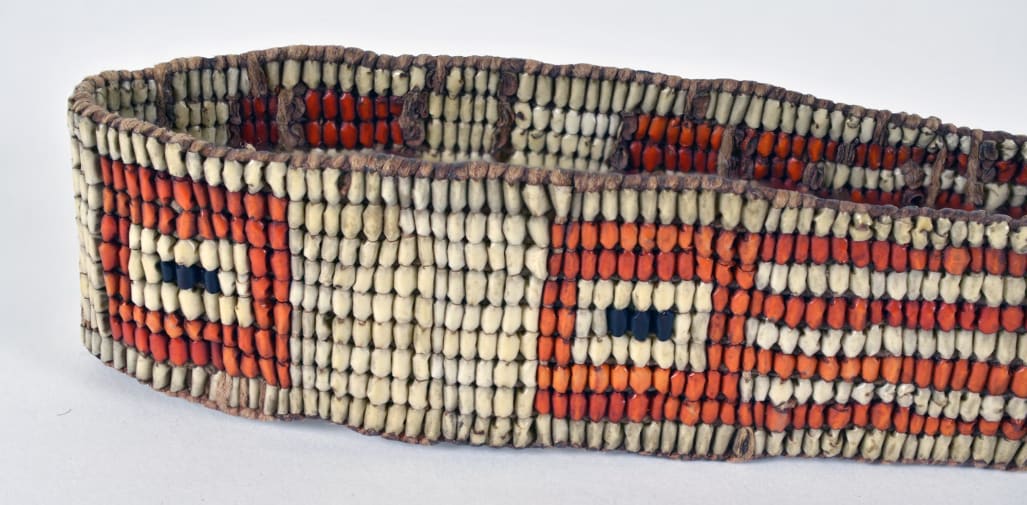Concepts Have Teeth
Project duration: 1 December 2020 - 30 June 2022
Funded by: AHRC (UK)
Concepts Have Teeth is an AHRC networking project. We are a group of Blackfoot-led researchers, artists, archaeologists and museum professionals working to connect historical Blackfoot objects held in collections in Britain with the Niitsitapi. The UK network is led by Louisa Minkin in conjunction with Knowledge Holders of the Blackfoot people and colleagues from National Museums Scotland, the University of Southampton, the University of Lethbridge, Canada.
The title of our project is directly from political anthropologist Audra Simpson:
Project summary
Concepts Have Teeth and its sister project on Blackfoot traditional territory Mootookakio’ssin [Distant Awareness] funded by a grant from the New Frontiers in Research Fund, administered by the Social Sciences and Humanities Research Council of Canada, aim to connect Blackfoot people living in North America with their cultural heritage held by museums in the UK. Directed by knowledge holders from Kainai, Piikani, Siksika, and Amskapipiikani nations, the project is a collaboration between Indigenous and non-Indigenous researchers, artists, archaeologists, museum professionals and students. The project uses digital imaging techniques, art-based public engagement and spatial web technologies. These tools will improve the ability of Blackfoot people to interact with their historical belongings and recover and shape their own narratives surrounding them.
Objectives
- To establish an expanded transdisciplinary network to share methods and local examples in the digitisation of collections to enhance understanding, connection and access and support cultural revitalisation for Indigenous communities, with specific reference to Blackfoot quillwork.
- To investigate how the critical approaches and practices of fine artists working with digital imaging technologies can contribute to conceiving new space as active platforms for co-production, consultation and event-based learning across disciplines and audiences.
- To examine how digital imaging techniques (in dialogue with traditional makers in the Blackfoot community) could be utilised to reveal and share lost knowledge of crafting techniques relating to Blackfoot artefacts in UK museums.
- To examine the role of Indigenous knowledge in strategies of digital documentation, and how this knowledge might act as leverage to question wider interpretations and. assumptions relating to the ontological composition of material culture.
Project team
Blackfoot Advisory Group
- Knowledge Holders from Kainai, Piikani, Siksika, and Amskapipiikani are directing the project
- Jerry Potts
- Velma Crowshoe
- Kent Ayoungman
- Linda Little Chief
- John Murray
- Carol Murray
- Martin Heavy Head
- Leroy Littlebear
- Amethyst First Rider
UK project team
- Principal Investigator: Louisa Minkin, Reader in Visual Art Practices at Central Saint Martins
- Andrew Meirion Jones, Professor of Archaeology, University of Stockholm
- Co-Investigator: Ian Dawson, Co-Director of the Critical Practices Research Group, Winchester School of Art, University of Southampton
- Thomas Allison, artist, CSM
University of Lethbridge Research Team
- Christine Clark, Assistant Professor of New Media
- Josephine Mills, Director and curator of the U of L Art Gallery
- Danielle Heavy Head, Blackfoot Digital Library liaison
- Jackson 2Bears, Canada Research Chair in Indigenous Arts Research and Technology.
- Marcus Dostie, Geography instructor
- Melissa Shouting, Master Student in Health Science
National Museums Scotland
- John Giblin, Keeper for the Department of World Cultures
- Ali Clark, Senior Curator: Oceania and the Americas
University of Aberdeen
- Alison Brown, Professor of Social Anthropology
- Museums and Special Collections
Hastings Museum and Art Gallery
- Eleanor Lanyon, Collections and Engagement Curator
Related links
- Read more about the Concepts Have Teeth project
- Explore Blackfoot Digital Project work in process
- Read about colonial histories and legacies in our museums
- Discover the Blackfoot Digital library
- Read the National Museums Scotland blog about Concepts Have Teeth

